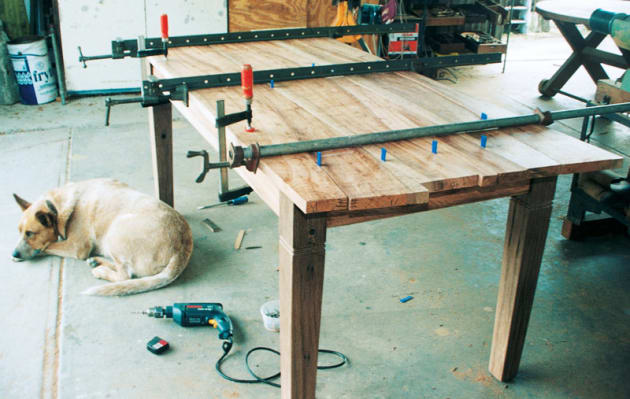River Lines Outdoor Table
Words and photos: Jamie Bell
If you like timber that dries without splitting or warping, is easy to work with and doesn’t push your tools and patience to the limit, then avoid river sheoak (Casuarina cunninghamiana). Usually found growing along creeks (if not in them) in northern NSW and Qld, river oak is also hard enough to have been valued by Aboriginals for tool and weapon making. But its spectacular wild and varied grain, and beautiful orange to red colour, is what makes it one of my favourite woods.
I came across two trees that were uprooted in floods. As they had not been slabbed immediately, and could not freely contract as they dried, they had some serious splits. This forced some lateral thinking when it came to making the table shown here, as straight cuts to remove the split centre sections would have left six narrow boards and a very narrow table. Following the curves of the splits saved timber and added interest to the design.

Above: Split sections were cut out following the direction of the grain.
The table was to go outdoors but undercover—on the verandah of a Queenslander—so I did not glue the top boards together. Separated, they can expand and contract with changes in humidity.
Legs
For the legs I used some 100 x 100mm grey ironbark salvaged from electricity pole cross-arms. This dark brown timber complemented the orange river oak, and as the 20mm holes that once held the ceramic insulators tell its history I left these unplugged.

Salvaged ironbark electricity pole cross-arms were used for the legs.
I planed this rough timber with an electric hand planer before squaring it on the jointer and thicknessing it — hand planer blades are cheaper and easier to sharpen than machinery blades if you hit a nail.
The river oak rails are joined to the legs with three 75 x 16mm dowels. By using 24 hour epoxy resin and adding 50 x 50mm pegged blocks this makes a strong joint. A 2mm deep V-groove cut along the dowel lets excess glue escape.
The legs were taper sawn on the bandsaw on all sides to lighten the look of the table.

50mm square blocks add strength to the leg joinery
I routed the horizontal detail by clamping the four legs together and setting up a fence. This design detail disguises where the leg taper begins, and by relating to the 5mm gaps between the top boards it also visually connects the base to the top, helping to unify the piece. The legs and stretchers were then sanded before being clamped up. The top boards were clamped in position before being attached to the base.

The legs were clamped together to add the routed detail.
The top

I scribed each pair of boards to match the curves. After sitting for a week or so these boards bowed away from each other, and as re-scribing them would have made the top too narrow I had to secure them in place while under tension — a reminder that large boards with curved grain should be left to settle after resawing alters the tensions in them.
The boards were connected to each other with three 35 x 25mm cleats. I used roofing screws for this—with hex socket heads that won’t burr, 12-gauge thickness for strength, and galvanised to deter rust. I placed these screws centrally so the boards could expand and contract either side of them.
I also inserted acrylic 12mm dowels 50mm in from the ends to align the boards — acrylic instead of timber so that during wet weather, when the wood will expand, these sliding joints will be less likely to seize. Acrylic dowel is available in various sizes from plastics fabricators. The top was connected to the base by a cleat at either end and timber buttons along the sides.
Before finishing I filled the numerous small cracks in the top with epoxy resin. I normally heat the resin to make it flow more easily, but on this table I used an iron to heat the wood instead. This worked well, but don’t try it on a soft wood like red cedar, unless you want to create authentic looking old iron burns.
I belt sanded the top with 60 then 120 grit, across the grain first to level the boards then with the grain, and finish hand sanded with 180 grit. As the edges of the top boards had some sapwood I washed the boards with a bleach solution, then used a timber sterilising mould and mildew treatment before applying three coats of outdoor furniture oil.
Cutting list
Top: 1800 x 850 x 30mm
Legs: 4 x 750 x 90 x 90mm
Rails: 2 x 1440 x 120 x 30mm, 2 x 620 x 120 x 30mm
Cleats: 3 x 720 x 35 x 25m, 2 x 620 x 35 x 35mm
Blocks: 8 x 115 x 50 x 50mm

This story first appeared in Wood Review magazine issue 28. Learn more about Jamie Bell at www.jamiebell.com.au




